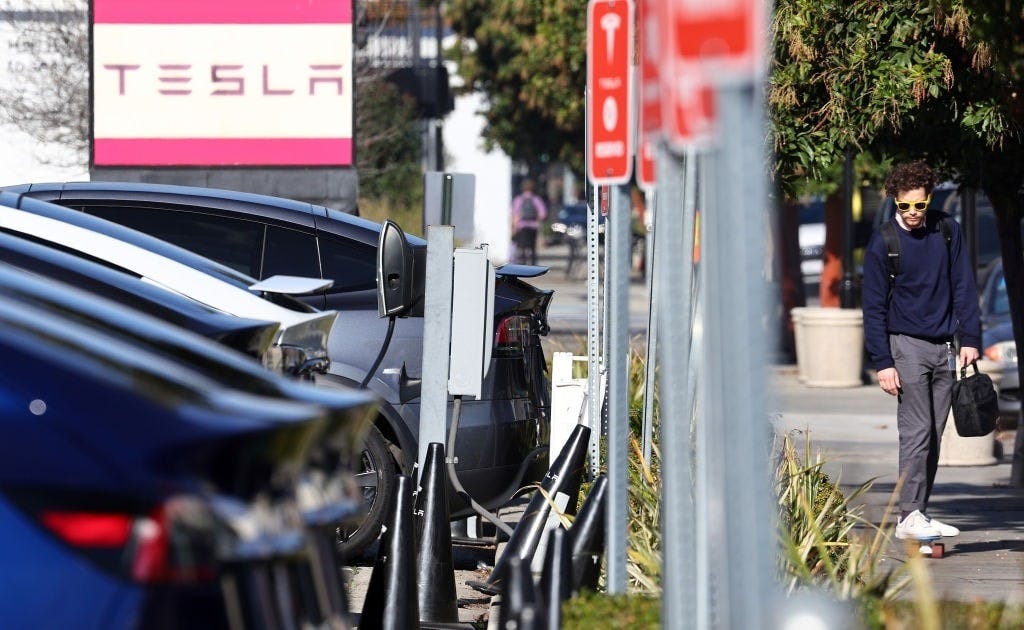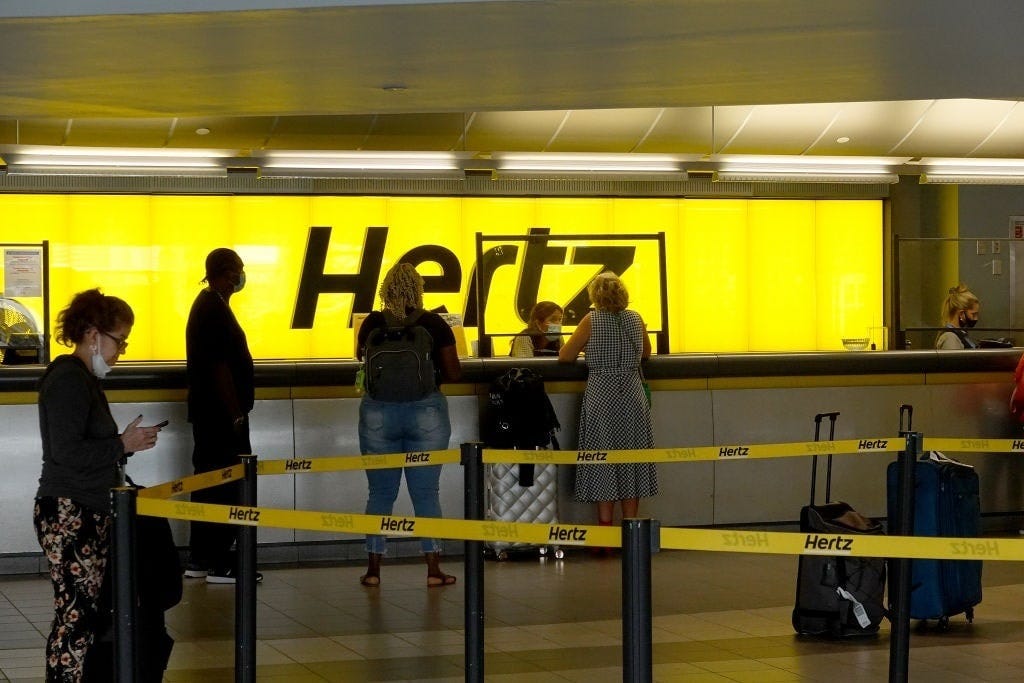(Photo by Kevin Dietsch/Getty Images)
The nation’s recent deep freeze stranded many expensive electric vehicles (EVs) with drained batteries, often in front of charging stations equally disabled by the cold. Warmer areas like California, where some 39% of EV car owners reside, do not abuse their batteries with the harsh seasonal winters that threaten many regions of the nation and world. Electric vehicle sales were quite chilly even before the arctic blast, despite price drops and government subsidies. The cold weather troubles reveal why the market for this vaunted technology may continue to cool.
Car Conspiracy
The 2006 documentary “Who Killed the Electric Car?” explored the possibility that government and industry forces conspired to ensure the failure of the prototype electric vehicle of the mid-1990s: the General Motors EV1. EVs may have been viewed as a threat to oil or automaker profits, but automakers claimed the failure of the vehicles to succeed was primarily attributable to a lack of consumer demand. Current public displays of the sharp drop in efficiency of electric batteries in frigid environments will not boost popularity, instead offering yet one more reason for consumers to prefer the traditional gasoline engine.
(Photo by Mario Tama/Getty Images)
EVs are relatively expensive, and many remain skeptical that charging stations and electric grids can support them – even in warmer temps. Growing awareness of the pollution generated in the mining of lithium and other materials in EV battery and vehicle manufacturing (and the eventual disposal of non-recyclable batteries) undermines the environment-sparing messaging used to justify the hefty price tag. And then there is “range anxiety.”
Range Anxiety
Range anxiety refers to the understandable concern of consumers that EVs lack the ability of gas-powered cars to travel long distances reliably. Indeed, concerns about vehicles that could, at that time, travel less than 100 miles per charge were likely part of the lack of consumer appeal for GM’s EV1 in the 1990s. Today’s models approach the three-hundred-mile range – until it gets too cold. Car batteries lose energy much faster when the thermometer plummets and the increased energy requirement to keep the driver and passengers warm certainly doesn’t help. It is estimated that sub-freezing temps can reduce EV range by 40% when the heater is on.
Many consumers will hesitate to buy a vehicle in which turning on the heat could leave them stranded on the roadside in life-threatening weather. In the recent cold snap, many EV owners claimed their cars would not charge at all or that charging stations failed to function. And while EV proponents claim gas stations too are vulnerable when the power goes out (and that future EVs will permit charging other vehicles), it is a familiar rescue to Americans when someone pulls a can of gasoline from the back of their truck to get “old-fashioned” motorcars back on their way.
Electric Vehicle Rental Disappointment
(Photo by Joe Raedle/Getty Images)
Hertz Rentals launched an ambitious EV car rental program, purchasing 100,000 EVs and installing charging stations for its users. The plan has been back-pedaled as the company recently shed about a third of its EV fleet. Rental customer experience may have a lot to reveal about the broader long-term salability of EVs.
Americans often rent cars for long journeys, perhaps seeking a more reliable vehicle than their personal auto, or to spare it the extra mileage or risk of a far-from-home breakdown. Road trips are part of the American wilderness experience, a la Jack Kerouac. Such journeys tackle long distances over this grand American geography: Many people drive hundreds of miles a day, or even through the night, to reach their vacation or business destination.
Enter the electric vehicle rental. Depending on the departure location, there may or may not be ample charging stations en route. An app or other electronic access is also required before departure in order to use the electric charging stations, as no cash is allowed. The stop will not be a three-minute fill-up with coffee and donuts as in the gas station era, but likely a one-hour affair (if the charging stations are operational and available, and if it’s not sub-freezing). Some technologies (Tesla Superchargers) can accelerate charging times, but it is still far more time-consuming to juice a battery than to simply pump petrol: EV charging stations cannot recharge cars anywhere near as fast as liquid fuel stations.
A traveler hoping to drive 750 miles or more in one day to a family member’s wedding, graduation, funeral, etc., would thus have to make at least two lengthy stops with an electric vehicle rental, making an already-exhausting journey dangerous, perhaps necessitating a hotel and an extra day (or two, if returning) car rental. Better to take a gasoline-powered rig.
Hertz admits as much on its website:
“But if you’re keen to explore the many benefits of driving an electric car – low emissions, a quieter ride, and lower running costs among them – don’t let range anxiety stop you from giving it a go….
“So, while you won’t be able to drive from dawn till dusk, EVs are great for day-to-day driving and multi-stop road trips. Electric cars also offer better efficiency in city settings, thanks to regenerative braking: the ability to build up power reserves when stopping repeatedly.”
Many Americans want to drive from dawn till dusk, or even from dusk till dawn. Hertz also experienced higher repair and tire costs with its EV fleet. Repair costs for bodywork on EVs (especially Teslas) are generally substantially higher than for gas-powered vehicles; EVs go through tires 30% faster. All of these are negative factors not just for car rental companies, but individual American car buyers increasingly concerned about a wobbly economy in an even wobblier election year.
Freedom of Safe Travel
A subconscious instinct against dependency infuses pictures of EVs parked in darkness due to harsh, frigid elements. If there is a time consumers want dependability for their loved ones, it is in times of emergency such as a winter storm. Then there are the many consumers accustomed to the self-reliance of a woodstove or generator, who are also reluctant to relinquish that independence for the techno-enslavement of heat pumps. Like EVs, heat pumps decline in efficiency as temperatures drop. Even with improvements to this problem, there remains a complete dependence upon the electric grid for life-saving warmth. The Boy Scout motto of “Be Prepared” is pretty useless if all one can do is wait for the power to come back on to stave off hypothermia in a home or car.
Like a load of heavy, wet snow on a cheap tin shack, the numerous problems that accompany EVs promise to break the unfulfilled technological promises and dubious climate justifications concocted to prop them up. Winter storms reveal EVs stalled in squalls with dead batteries; summer EV driving threatens California with blackouts. Lithium mining and battery disposal eclipse the claimed environmental benefits of carbon dioxide reduction, and EV subsidies are “inequitably” regressive.
With such a fast-growing list of insurmountable problems, the EV appears to be killing itself.
(Previously published at Liberty Nation.)








The novelty is wearing off, as well. It's slowly becoming "uncool" to own an EV. Non-EV owners resent their taxes and electricity bills reflecting EV subsidies.
Hi John,
Thanks for your illumination of the EV dilemma.
Little is said by government, purveyors of EVs, or the self enlightened cheer leaders for EVs and solar power. The cost for materials, processing and disposal are all kept under the green cover rug in hopes the subjects never come up before the product is sold. No one raises the question about coulomb refueling - where did the energy come from, how "clean" is it really and where, other than in cities can the coulomb refueling be conducted, let aside the time to accomplish it and associated risk of being assaulted while one waits to get recharged.
EV work ok in cities, where you can shop, catch a bus, or walk while the vehicle is charged, hopefully still there & charged when you get back. Use on a golf course would be ok also for similar reasons.
Public ignorance is vulnerability. Investigatory diligence before purchase leads to a happier solution.